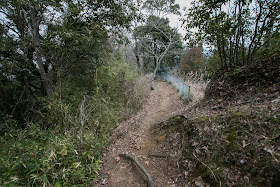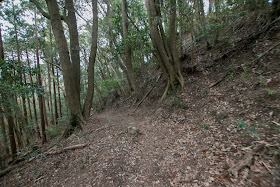Kururi Castle
-History of peninsular brave (7) seesaw game-
Overview
Name: Kururi Castle (Kururi-jo)
Alias:
Place: Kururi Kimitsu city, Chiba
Type: Mountain Castle
Built: Originally in 15th century, expanded in 1550's
Remaining remnants: Clay walls and dry moats
Title:
Brief History
Continued from Part 6
Kururi castle (久留里城) is located at the Shiroyama mountain, one of 100 meter height from hillside at Kururi area. The south half of Boso peninsula is a mountainous area separated by valleys and rivers, and valleys of rivers flows from mountains toward north have been used as communication route of north half and south half.
Kururi area is a wide valley at the upper stream of Obitsu river which runs middle part of Boso peninsula. Located just at the center of Boso peninsula, Kururi area is connected to four directions of the peninsula by roads, and it is the most suitable place to manage the whole peninsula.
Origin of Kururi castle
The precise year of construction is unknown but Kururi castle was built and used by Mariyatsu Takeda clan by the beginning of 16th century. Mariyatsu Takeda clan was a local lord stem from Nobunaga Takeda (?-1477), a distant relative of Takeda clan which was governor of Kai province (Yamanashi prefecture).
At the battle of Ashikaga clan and Uesugi clan in the latter half of 15th century, Mariyatsu Takeda clan was sent to Kazusa province (middle part of Boso peninsula) by Koga Kubo Highness, and built their main base Mariyatsu castle (Chiba prefecture) and Chonan castle (Chiba prefecture).
By 1530, under Jokan Mariyatsu (?-1534) Mariyatsu Takeda clan expanded their territory to most part of Kazusa province (middle part of Boso peninsula) then became a strong warlord of this area. Mariyatsu clan built most part of major castles in Kazusa province such as Kururi castle, Sanuki castle, Otaki castle or Mangi castle along with their main base Mariyatsu castle.
But due to continuous internal conflicts aiming at leader position after death of Jokan, Mariyatsu clan became weakened and was supressed by Hojo clan, which was the warlord of Sagami province (Kanagawa prefecture) already held main body of Kanto region, and Satomi clan which grew at Awa province (south edge of Boso peninsula). Finally Mariyatsu clan was virtually destroyed by Satomi clan and Kururi castle was captured by Satomi clan.
Growth of peninsular brave
Satomi clan was a traditional clan which was a branch house of Nitta clan, a major house of Minamoto family and rival of Ashikaga clan, which established Muromachi Shogunate. Precise situation is unknown but Satomi clan landed Awa province (south half of Boso peninsula) in the latter half of 15th century under the order of Ashikaga clan, same as Mariyatsu Takeda clan.
Soon Satomi clan gathered local naval clan and seized Awa province beating existing local lords in 20 years from their main base Inamura castle (Chiba prefecture). At the time of Yoshimichi Satomi (?-?), Satomi clan started to expanded to east part of Kazusa province, and gained Masaki clan, a powerful local lord of the area, as their retainer.
But after the death of Yoshimichi, there arose an internal conflict named "Tenbun no Naikou" (conflict in Tenbun period) in 1534, and Yoshitaka Satomi (1507-1574), born as side line of the clan, ruined Yoshitoyo Satomi (?-1534), the head of main family and gained the leader position under support of Hojo clan, the fatal rival of Satomi clan.
Start of long battle between two clans
However, after the seizure of leader position, Yoshitaka Satomi broke with Hojo clan. Just at time the first battle of Konodai occurred at current Ichikawa city, between Hojo clan and an alliance of Ashikaga clan, Mariyatsu clan and Satomi clan. The alliance lost the battle then leader of Ashikaga clan died and Mariyatsu clan also get confused. But Yoshitaka left the battlefield without damage, then ruined weakened Mariyatsu clan and seized whole Kazusa province.
On the other hand, Hojo clan who won at the battle virtually gained Shimousa province (root of Boso peninsula and western part of Chiba prefecture). Now Satomi clan and Hojo clan directly faced and long battle of both clan started. As it occurred at narrow and straight peninsula and there were only two participants, the battle became an American Football like one with the front line moving up and down, with a naval battle outside of the field.
Structure of Kururi castle
Satomi clan built a defense line by Sanuki castle at west, Kururi castle at middle and Otaki castle at east in the middle of Boso peninsula, and Kururi castle was used as a main base of the clan. Satomi clan had a characteristic style of mountain castle, which build narrow path to every ridge from the peak, instead of ordinary style digging the ridge into flat terrace.
It seems like a neuron looking at the map consist of numerous long line spreads from the peak and divides at the end. This style might be generated under the condition of mountains at Boso peninsula with narrow ridges, and might be effective to encircle flat space and keep the enemy distant.
Shiroyama mountain has two peaks, the former is used as a central area where tower like building locates, and another is the secondary area now used as a ground of museum. From these two core areas, two ridges spreads to northwest and one ridge prolongs to southeast, the backside of the castle. The western one of two front side ridges is developed as a route to museum and lost is shape, but eastern one and backside one still keeps original style of narrow road, protected by huge clay walls and dry moats here and there.
In addition to this, a small hill ahead of two front side ridges was also used as a part of castle, with line of clay walls. As this small hill worked as a lid, a flat area between two front side ridges now used as a parking became a large safe space, and might be used as a residence of the lord or storage place. Total size of the castle is about 1,000 meter long and 400 meter wide, and total length of clay line might exceed 3 kilometer. This huge castle exactly matched as a main base of Satomi clan at its peak.
Offense and defeat
Yoshitaka fiercely fought with Hojo clan for Kazusa province and naval supremacy of Tokyo bay, but Hojo clan had far larger territory and much soldiers than Satomi clan, and fixed their backward by alliance with Takeda clan and Imagawa clan. Hojo clan sent whole army to Kazusa province and urged local lords under Satomi clan to leave, then Satomi clan once lost the most part of Kazusa province.
In 1560, finally Hojo clan reached to Kazusa province and attacked Kururi castle. At this crisis, Yoshitaka Satomi securely protected Kururi castle asked assistance to Kenshin Uesugi (1530-1578), the warlord of Echigo province (Niigata prefecture), and fatal rival of Hojo clan. Kenshin lead large army intruded into Kanto region and quickly marched to Odawara castle (Kanagawa prefecture), the main base of Hojo clan. Finally Kenshin could not fall Odawara castle, but Yoshitaka Satomi was rescued.
Looking at upset of Hojo clan at this expedition, Yoshitaka again tried to expand into Kazusa province. But Hojo clan quickly restored the situation, and both army again fought at Konodai in 1563. Satomi army won at the prelude but became careless, thus at main battle Satomi army suffered severe defeat and lost their important retainer Tokishige Masaki (1540-1564). After this battle, Masaki clan itself left Satomi clan and changed to Hojo clan.
Lord of never give up
But Yoshitaka still did not yield to Hojo clan. He restored his army and recovered lost territory from Hojo clan in several years. Facing this situation Hojo clan sent a large army and stayed them at Mifuna-yama, a hill at west coast near the border. In 1567, Yoshitaka attacked Hojo army at Mifuna-yama from land and sea, and broke dominant Hojo army including Ujimasa Hojo (1538-1590), the successor of Hojo clan.
At the same time Satomi navy also broke Hojo navy at sea, thus Hojo army feared lack of supply retreated from Kazusa province. By this victory Satomi clan restored Kazusa province, and pushed up the front line into Kazusa province again. Yoshitaka made even match against far stronger Hojo clan after several serious defeats, and was praised for his braveness and intelligence.
But in 1569, due to the breakup of Hojo clan and Takeda clan of Kai province, Hojo clan made an alliance with Kenshin Uesugi who supported Satomi clan before. Now Hojo clan could devote themselves into Kazusa province, not fearing backside attack from Kenshin. In response to this Yoshitaka made alliance with Takeda clan, but it was not a direct support to Satomi clan.
Cease fire and afterward of castle
Under such situation, Yoshitaka died in 1574, and Satomi clan became confused concerning his successor. Under such situation Satomi clan became inferior to Hojo clan, and finally an agreement between Satomi clan and Hojo clan stating cession of territory to Hojo clan was made in 1577.
Satomi clan kept south part of Kazusa province but substantially subordinated to Hojo clan. Satomi clan retreated its base from Kururi castle to Okamoto castle (Chiba prefecture), at the border of Awa province and Kazusa province, and devoted to the restoration of the clan.
After the extinction of Hojo clan by central ruler Hideyoshi Toyotomi (1537-1598) in 1590, Kazusa province including Kururi castle was given to Ieyasu Tokugawa (1543-1616). Tadamasa Osuga (1581-1607) was appointed as a commander of the castle, and Kururi castle was transformed into a modern one.
A two story main tower was built at hilltop, and palace of lord was newly built at hillside area. Throughout Edo era, Kururi castle was managed by hereditary retainers of Edo Shogunate as one of the main base at Boso peninsula.
Subsequent to Meiji revolution all building were lost. Now an imitation of main tower was built next to original basement at narrow central area, and local museum also exist at secondary area. Now we can see only a part of the whole castle, but steep walls spread whole mountain impress us the authority of the leader and existence of strong enemy.
Continue to Part 8
Access
20 minutes walk from JR East Kururi-sen Kururi station. 20 minutes drive from Kennodo Expressway Kisarazu-Higashi interchange. 20 minutes walk from hillside entrance to hilltop castle.
Related Castles
Mariyatsu Castle -History of peninsular brave (5) sudden fall of rival let way open-
Inamura Castle -History of peninsular brave (2) Coup d'etat erased from history-
Konodai Castle -History of peninsular brave (6) two time defeats at same battlefield-
Usui Castle -History of peninsular brave (8) Joint struggle with god of war-

















































































































































































































































































































No comments:
Post a Comment